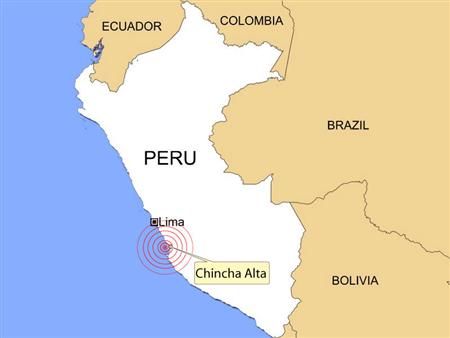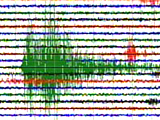Aug 15, 2007 10:50 PM
LESLIE JOSEPHS
Associated Press
LIMA, Peru – A powerful earthquake shook Peru's coast near the capital on Wednesday, killing at least 17 people as it toppled homes and caused many residents to flee buildings. Authorities said the quake had generated a tsunami of undetermined size.
Peru's highly respected Cable news station Canal N reported that the 7.9 magnitude quake had caused a church to collapse in the city of Ica south of Lima, killing 17 people and injuring 70.
The Hawaii-based Pacific Tsunami Warning Center initially issued a tsunami warning for the coasts of Peru, Chile, Ecuador, Colombia, Costa Rica and Panama. A tsunami watch was issued for the rest of Central America and Mexico. It also issued a tsunami advisory for Hawaii.
The center later canceled the warnings and the watches, but it said the quake had caused a tsunami of unknown size.
"Sea level readings indicate a tsunami was generated," the center said on its Web site. It did not report the tsunami's size, but said it could be large enough to "be destructive" on coastal areas near the quake's epicenter.
The U.S. Geological Survey said the earthquake hit at 6:40 p.m. (7:40 p.m. EDT) about 90 miles southeast of Lima at a depth of about 25 miles. Four strong aftershocks ranging from magnitudes of 5.4 to 5.9 were felt afterwards, the USGS said.
An Associated Press photographer said that homes had collapsed in the center of Lima and that many people had fled into the streets for safety. The capital shook for more than a minute.
Firefighters quoted in radio reports said that many street lights and windows shattered in Lima but did not specify if there were any injuries. Hundreds of workers were evacuated from Lima office buildings after the quake struck and remained outside, fearing aftershocks
Callers to Radioprogramas, Peru's main news radio station, said parts of several cities in southern Peru had been hit with blackouts. Callers reported homes in poor neighborhoods in Chincha and Cerro Azul had collapsed.
The quake also knocked out telephone service and mobile phone service in the capital. Firefighters were called to put out a fire in a shopping center. State doctors called off a national strike that began on Wednesday to handle the emergency.
Alex Kouri president of the Callao region, which includes the port of Callao, adjacent to Lima, urged residents to remain calm in the face of any possible tsunami, while other officials told Radioprograms they were going to evacuate La Punta, a Callao neighborhood, because of the potential threat of a tsunami.
In Colombia, President Alvaro Uribe ordered the partial evacuation of the southern city of Tumaco in response to the warning.
In a press conference, Uribe said residents living along the coastal areas of Tumaco, Colombia's southernmost city near the border with Ecuador, should immediately move to higher ground as a preventive measure in case a tsunami strikes.
"The reports we received about a possible tsunami are contradictory so we've asked that, according to emergency disaster plans, authorities immediately begin the partial evacuation of Tumaco," said Uribe.
The last time a quake of magnitude 7.0 or larger struck Peru's central coast was in 1974 when a magnitude 7.6 hit in October followed by a 7.2 a month later.
The latest Peru quake occurred in a subduction zone where one section of the Earth's crust dives under another, said USGS geophysicist Dale Grant at the National Earthquake Information Center in Golden, Colo.
Some of the world's biggest quakes strike in subduction zones including the catastrophic Indian Ocean temblor in 2004 that generated deadly tsunami waves.
–––––
Associated Press writer Alicia Chang in Los Angeles contributed to this report.
Peru Stages Rescue Operation as Quake Kills 60 People
By Alex Emery
Aug. 16, 2007 (Bloomberg) -- Rescue workers in Peru searched for survivors and state health workers struggled to treat hundreds of injured after a magnitude 7.9 earthquake toppled buildings along the southern coast, killing at least 60 people.
Peru's largest earthquake in more than 30 years forced the government to declare a state of emergency and prompted countries such as Mexico and Panama to pledge aid. It was the world's biggest quake since an 8.1 magnitude temblor stuck off the Solomon Islands in May, triggering a tsunami that killed 54 people.
At least 60 people were killed and 800 injured in the southern coastal town of Ica where buildings and a church collapsed, Mayor Mariano Quispe told Radioprogramas, a radio station based in the capital, Lima.
``There have been losses in the south,'' Peruvian President Alan Garcia said in a broadcast late yesterday on Radioprogramas.
Ten aftershocks of magnitude 5 or greater hit the area, including a magnitude 6.3 tremor at 0:16 a.m. Peru time, the U.S. Geological Survey said on its Web site.
Thousands of people chose to camp out on public squares rather than risk facing the aftershocks inside their homes. Looting was reported in several towns because of power and telephone outages.
Emergency Status
Police and state hospitals were placed on emergency status and schools suspended today, said Garcia, who held an emergency session of his Cabinet at the presidential palace late yesterday. Emergency services will review schools, roads and bridges today for damage, he said.
State doctors called off a strike to attend the injured, Health Minister Carlos Vallejos said.
Hospitals were overflowing with the injured in the southern coastal towns of Chincha, Canete and Ica, according to state news agency Andina. Ica's 16th century Senor de Luren church, one of the oldest in the Americas, collapsed late yesterday during Mass.
Jorge Chavez international airport in Lima canceled all domestic flights and City Hall closed coastal roads.
The temblor hit about 90 miles (145 kilometers) south- southeast of Lima, the USGS said. Tens of thousands of people evacuated office buildings in the capital's financial quarter of San Isidro.
Tsunami Alert
Fishermen battled heavy seas to drag their launches onto dry land south of Lima in response to a tsunami alert. The quake set off tsunami signals and advisories for Peru, Colombia, Panama, Costa Rica, Nicaragua, Guatemala, El Salvador, Mexico, Honduras and Hawaii. The alerts were later canceled.
In the Chilean city of Santiago, dozens of passengers were stranded at the airport after Gol Linhas Aereas Inteligentes SA, Brazil's second-largest airline, canceled a flight to Lima because of the quake, Television Nacional reported.
The quake was felt as far north as Colombia's capital, Bogota, and as far south as Coquimbo, Chile, about 2,000 kilometers (1,200 miles) from Lima. There were no reports of injuries or property damage, the Chilean Interior Ministry's National Emergency Office said on its Web site.
A magnitude 7.0 earthquake carries roughly as much energy as 199,000 tons of TNT, according to the USGS. That energy is spread out in waves and not in one particular spot.
Dale Grant, a geophysicist at the National Earthquake Information Center in Golden, Colorado, said it is the largest earthquake in Peru since 1974.
To contact the reporter on this story: Alex Emery in Lima at aemery1@bloomberg.net

